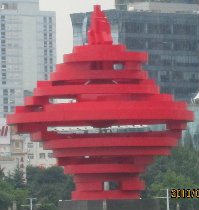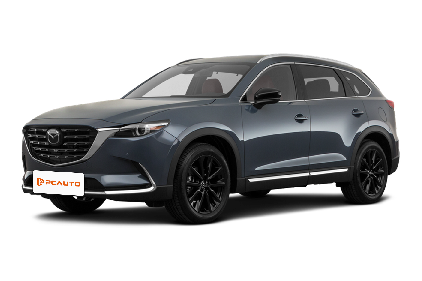Q
How many km per liter is a Mazda CX-9?
According to official data, the fuel economy of the Mazda CX 9 is roughly between 10 and 12 kilometers per liter of gasoline. The exact figure depends on driving conditions, road conditions, and vehicle configuration. For instance, the fuel consumption of the 2.5-liter turbocharged engine paired with a four-wheel-drive system is slightly higher than that of the front-wheel-drive version. In Malaysia, heavy traffic in the city may lead to higher fuel consumption, while driving on the highway can get closer to the ideal figure. Mazda's Skyactiv technology enhances fuel economy by optimizing engine efficiency and lightening the vehicle body, while maintaining power output. For consumers who are concerned about fuel consumption, it is recommended to regularly maintain tire pressure and engine condition and avoid aggressive driving. These habits can significantly affect the actual fuel-consumption performance. When compared with other SUVs in the same class, the CX-9's fuel consumption is at a medium level, but its handling and interior quality are still outstanding advantages, making it suitable for family users who pursue a great driving experience.
Special Disclaimer: This content is published by users and does not represent the views or position of PCauto.
Related Q&A
Q
Is the CX-9 fast?
The Mazda CX-9 is a large SUV with decent power performance in the Malaysian market. It's equipped with a 2.5-liter turbocharged engine, which outputs 227 horsepower and 420 Nm of torque. Paired with a 6-speed automatic transmission, the power output is smooth and sufficient to meet the needs of daily driving and high-speed overtaking. The 0 - 100 km/h acceleration takes about 8 seconds, which is relatively fast for a 7-seater family SUV. Although the acceleration performance of the CX-9 can't compare with that of performance SUVs, it's above average in its class. Especially, it has strong mid-range acceleration ability, making it suitable for driving on Malaysian highways. It's worth noting that the CX-9 uses Mazda's Skyactiv technology, which balances power and fuel economy. This is a good trade - off for Malaysian consumers. If you're after more powerful performance, you can consider some competitors with V6 engines. However, the CX-9 strikes a great balance between power, space, and fuel consumption, making it particularly suitable for Malaysian family users.
Q
How big is a CX-9 gas tank?
The fuel tank capacity of the Mazda CX-9 is 72.5 liters. This design can meet the needs of family long-distance trips, reducing the inconvenience of frequent refueling. For users in Malaysia, such a fuel tank size can provide good cruising range while taking fuel economy into account, which is especially practical when traveling across states or on self-driving tours. As a mid-to large-sized SUV, the CX-9 is equipped with an efficient power system. The fuel tank volume matches the fuel consumption performance of its 2.5-liter turbocharged engine, ensuring a reasonable driving range under comprehensive road conditions.
In addition, it is recommended that car owners regularly check the condition of the fuel tank and the oil circuit system and maintain good driving habits, such as smooth acceleration and reasonable use of cruise control, to further improve fuel efficiency. At the same time, pay attention to avoid exposing the fuel tank to the sun for a long time in Malaysia's hot climate, so as not to affect fuel evaporation and system safety.
Q
How many kilometers can a Mazda CX-9 do?
As a mid-large SUV, the durability and mileage performance of the Mazda CX-9 mainly depend on daily maintenance and driving habits. Under normal use and regular maintenance, the CX-9 can reach a mileage of 200,000 to 300,000 kilometers or even more. Many owners have reported that the vehicle can maintain stable performance in the long run with good maintenance.
For users in Malaysia, the hot and humid climate may have a certain impact on vehicle components such as rubber seals and batteries. It is recommended to regularly check the cooling system and air-conditioning system, and replace the engine oil and filters according to the manufacturer's recommended maintenance schedule to extend the engine life.
The Skyactiv-G turbocharged engine equipped in the CX-9 has mature technology, and it performs well in terms of fuel economy and reliability, making it suitable for long-distance family trips. In addition, the rainy weather in Malaysia places certain requirements on the braking system and chassis anti-rust. It is recommended to regularly clean the chassis and check the thickness of the brake pads.
If you want to learn more about specific maintenance details, you can refer to the maintenance manual provided by Mazda Malaysia official or consult the authorized service center.
Q
What is the fuel consumption per 100km of the Mazda CX-9?
According to official data, the combined fuel consumption of the Mazda CX-9 in the Malaysian market is approximately 8.5 to 9.5 liters per 100 kilometers. The specific figure depends on driving habits, road conditions, and vehicle configuration. For example, the 2.5-liter turbocharged engine equipped in the vehicle has better fuel-consumption performance during high-speed cruising, while it will be slightly higher in congested urban areas. Malaysian car owners can refer to this data as a benchmark for their daily driving. At the same time, it is recommended to carry out regular vehicle maintenance, such as keeping the tire pressure normal and using the appropriate engine oil. These details can all help to optimize fuel economy.
In addition, Mazda's Skyactiv technology, with its efficient power system and lightweight design, provides ample power while also taking fuel-consumption performance into account. It is suitable for family users who value both the driving experience and practicality. If you have higher requirements for fuel consumption, you can also consider hybrid or pure-electric models. However, as a seven-seat SUV, the CX-9's fuel-consumption level is still competitive in its class.
Q
How long will a Mazda CX-9 last?
As a mid-large SUV designed mainly for family use, the Mazda CX-9 typically shows a durability of 150,000 to 200,000 kilometers or even more in the Malaysian market. The actual lifespan depends on the owner's maintenance habits and driving environment. Regularly changing engine oil, transmission fluid, maintaining the braking system and following the manufacturer's recommended maintenance schedule are the key factors. The hot and humid climate in Malaysia may have a certain impact on rubber components and electronic systems. It is recommended that car owners pay special attention to the inspection of the air-conditioning system and chassis parts.
The 2.5T turbocharged engine equipped in the CX-9 has mature technology and is paired with a 6-speed automatic transmission. The reliability of the powertrain has been verified by the market. However, for turbocharged models, more attention should be paid to the maintenance of the cooling system and intake system. When using this kind of large SUV in Malaysia, car owners also need to regularly clean the radiator to prevent overheating problems in the tropical climate, and choose regular gas stations to ensure fuel quality. If properly maintained, the CX-9 can fully meet the needs of Malaysian families for more than 10 years. Its relatively high resale value also reflects the market's recognition of its durability.
Q
What is the death rate of a Mazda CX-9?
Regarding the mortality data of the Mazda CX-9, the Malaysian official has not released the statistics on the traffic accident mortality rate of specific vehicle models. However, according to reports from multiple global safety evaluation institutions, the Mazda CX-9 performs excellently in terms of safety performance. For example, it has won the highest rating of "Top Safety Pick+" multiple times in the crash tests of the Insurance Institute for Highway Safety (IIHS) in the United States. This is due to its high-rigidity body structure, a well-developed airbag system, and advanced active safety technologies such as intelligent brake assist and lane-keeping assist.
For Malaysian consumers, when choosing an SUV, besides paying attention to safety ratings, they also need to consider local road conditions and driving habits. For instance, the G-Vectoring Control technology equipped in the CX-9 can improve handling stability on slippery roads. Regular maintenance and proper use of safety features (such as child seat interfaces) can further reduce risks.
It's worth noting that the mortality rate of any vehicle is closely related to factors such as driving behavior and road environment. Therefore, safety driving awareness and compliance with traffic rules are of crucial importance.
Q
Is CX-9 fuel efficient?
As a mid - large SUV, the Mazda CX-9 has above-average fuel efficiency among vehicles in the same class. The 2.5-liter turbocharged engine it's equipped with, combined with Skyactiv technology, not only provides sufficient power but also achieves relatively reasonable fuel consumption through optimized combustion efficiency and gearbox tuning. According to actual driving conditions, the combined fuel consumption is approximately 10 to 12 liters per 100 kilometers. For Malaysian users, although the fuel consumption of the CX-9 may be slightly higher than that of compact SUVs, considering its spacious interior and strong power output, such performance is still acceptable. If you focus more on fuel economy, you can consider hybrid models or diesel versions. However, the balance between performance and practicality of the CX-9 is still worth considering. Especially during family trips or long-distance drives, its comfort and safety can also offer a great experience.
Q
Do Mazda CX-9 hold their value?
The Mazda CX - 9's performance in terms of value retention in the Malaysian used-car market is above average. Its resale value is influenced by the brand's reputation, the vehicle's model positioning, and market demand. As an imported seven-seat SUV, the CX-9 has gained stable recognition among local middle-and high-end family users thanks to its KODO design language, SKYACTIV technology, and luxurious interior configuration. In particular, the post-2017 facelifted models are more popular as they have upgraded safety features like the i-ACTIVSENSE system.
However, its resale value is slightly lower than that of non-luxury brand hardcore SUVs such as the Toyota Fortuner. This is mainly because the latter has a larger market presence in Southeast Asia and lower maintenance costs. Nevertheless, the CX-9 can still maintain a relatively stable used-car price due to its more refined design and driving experience. Typically, a three-year-old CX-9 can retain about 60-65% of its original value.
It's worth noting that Malaysian consumers generally pay close attention to the maintenance records and original warranty status when purchasing a used CX-9. It is recommended to give priority to vehicles serviced at Mazda-authorized dealerships to safeguard their subsequent resale value. At the same time, one should be aware of the longer supply cycle of imported car parts. Regular maintenance and complete repair records can significantly increase the premium of a used car.
Q
Which country made Mazda CX-9?
The Mazda CX-9 is an SUV model designed and produced by the Japanese automaker Mazda. It is mainly targeted at the global market, including Malaysia. This vehicle is manufactured at Mazda's factory in Hiroshima, Japan, and it adopts the brand's latest KODO design language and Skyactiv technology, emphasizing the combination of a dynamic exterior and efficient power performance.
The CX-9 is quite popular in the Malaysian market. Thanks to its spacious three - row seat layout and luxurious interior configuration, it is suitable for family users. As a Japanese brand, Mazda has always focused on the driving experience and fuel economy. The 2.5-liter turbocharged engine equipped in the CX-9 not only provides ample power but also takes environmental protection performance into account.
For Malaysian consumers, the CX-9 is an imported SUV that combines practicality and brand reputation. Its Japanese manufacturing background also adds a guarantee of quality. Meanwhile, Mazda has a relatively complete dealer network and after-sales service system in Malaysia, which makes it convenient for car owners to carry out maintenance.
Q
What is the difference between a CX-8 and a CX-9?
The Mazda CX-8 and CX-9 are two SUVs with different positioning. The main differences lie in size, seat layout, and powertrain configuration. The CX-8 has a more compact body, measuring 4,900 mm in length. It offers three rows of seats but is more oriented towards flexible urban driving, making it suitable for the narrow roads in Malaysia. It is powered by a 2.5-liter naturally aspirated or a 2.2-liter turbocharged diesel engine, and it has a more economical fuel consumption
On the other hand, the CX-9 is positioned as a mid - to large - sized SUV, with a length of 5,075 mm. It has a more spacious interior. It comes standard with a 2.5-liter turbocharged gasoline engine, which delivers stronger power (250 hp/420 Nm) and is suitable for long - distance family trips.
Both cars adopt Mazda's KODO design language, but the CX-9 uses more premium interior materials and is equipped with more technological features such as a panoramic sunroof. In the Malaysian market, the price of the CX-8 is usually about 30,000 - 50,000 Malaysian ringgit lower than that of the CX-9. Consumers can choose according to their budget and needs. If they focus on fuel economy and daily commuting, the CX-8 is a good choice. If they pursue power and a sense of luxury, the CX-9 is more suitable.
It's worth noting that as an imported vehicle, the CX-9 has slightly higher maintenance costs, while the CX-8, which is locally assembled, has a price advantage. Both cars reflect Mazda's commitment to driving quality and safety, and all models come standard with the i-Activsense safety system.
Latest Q&A
Q
How much will 2025 Tucson cost?
The exact pricing for the 2025 Tucson hasn’t been announced yet, but based on the current model’s price range and its positioning in the compact SUV segment, we expect a starting price between RM140,000 and RM180,000. Final figures will vary depending on trim levels and optional extras.
The new model is likely to feature upgraded driver-assist tech, including more advanced lane-keeping and adaptive cruise control. Inside, we could see improved materials, a larger infotainment screen, and added convenience features like wireless charging.
With the compact SUV market getting more competitive, brands are packing in better tech while keeping prices sharp. If you’re interested, keep an eye out for official updates or check with local dealers for the latest offers. It’s also worth comparing specs and pricing against rivals to make the right choice.
Q
Will the Hyundai Tucson change in 2025?
Based on current information, the 2025 Hyundai Tucson is expected to receive several updates, likely including subtle exterior styling tweaks, interior upgrades, and enhanced tech features—such as a more advanced infotainment system or driver-assistance technologies. However, official details are still pending.
Hyundai typically refines design language and boosts tech offerings during mid-cycle updates, so the new Tucson may feature sharper lighting signatures or a larger touchscreen while retaining existing powertrain options, including gasoline and hybrid variants.
For buyers prioritizing practicality and technology, the Tucson has always been a solid value proposition in its class, offering spacious interiors and generous standard features that cater well to families. The refreshed model could further strengthen these strengths.
If you're considering a purchase, keep an eye out for official updates later this year to confirm specs and launch timing. It’s also worth cross-shopping rivals in the segment to ensure you’re choosing the right SUV for your needs.
Q
What is the resale value of a 2018 CLA?
**2018 Mercedes-Benz CLA Used Value Guide**
The resale value of a 2018 CLA depends on factors like condition, mileage, specs, and service history, typically ranging between RM100k to RM150k—exact pricing requires an in-person inspection. Thanks to the Mercedes badge and its coupe-like styling, the CLA holds decent demand in the used market, especially low-mileage examples with full maintenance records.
Key factors affecting price:
- Complete service history (dealer stamps preferred)
- Remaining factory warranty
- Exterior color (popular shades like black/white may command slightly more)
- AMG Line or higher trims can add 5-10% over base models
Note: Luxury cars take the biggest depreciation hit in the first 3 years, but the CLA (being an entry-level model) retains value better than most. Before selling, get a professional inspection and organize all receipts—it helps justify your asking price.
For reference, check comparable Audi A3 or BMW 2 Series listings, though the CLA’s frameless doors and brand appeal often give it a slight edge. For the most accurate valuation, review recent transactions on local used car platforms or visit an official Mercedes-Benz Certified Pre-Owned dealer.
Q
How much is a 2018 CLA 250 worth?
Here's a natural-sounding translation from an automotive editor's perspective:
"The 2018 CLA 250 currently holds a market value of around RM150k to RM180k, depending on factors like condition, mileage, specs, and service history. Well-maintained models with low mileage can fetch prices near the top end, while those with visible wear or accident records may drop significantly.
As Mercedes-Benz’s entry-level coupe, the CLA 250 packs a 2.0L turbocharged engine delivering 208hp and 350Nm of torque, paired with a 7-speed dual-clutch transmission. It offers sharp handling and lively performance—ideal for drivers who enjoy a sporty feel.
Inside, you’ll find a refined cabin with standard features like a multimedia system and reversing camera. Higher-spec variants might add extras like a sunroof or premium audio.
If you’re shopping for a used unit, always check maintenance records and get a professional inspection on critical components (engine, gearbox, etc.). For context, cross-shop rivals like the A 250 or BMW 2 Series from the same year to weigh your options thoroughly."
(Note: Adjusted "RM" placement for natural flow and trimmed some redundant phrasing while keeping the technical details and conversational tone.)
Q
What is the maintenance cost for a 2018 CLA?
**Maintenance Costs for the 2018 CLA**
The maintenance costs for a 2018 CLA can vary depending on the vehicle’s condition, mileage, and the services required. A standard service typically includes basic items like an oil and filter change, which may cost between RM 800 to RM 1,500—depending on the type of oil used and whether you go to an authorized dealer or a third-party workshop.
If additional services are needed, such as brake fluid replacement, air filter changes, or tire rotation, the cost could go up to around RM 2,000 to RM 3,000. To keep the car running smoothly, it’s recommended to service the CLA every 10,000 km or 12 months, whichever comes first.
As a luxury model, the CLA’s parts and labor costs may be slightly higher than mainstream brands. However, sticking to regular maintenance helps extend the car’s lifespan and prevents costly repairs down the road. To save on expenses, owners can consider prepaid service packages or reputable independent workshops. Just make sure to keep full service records—it’ll help maintain the car’s resale value.
View MoreRelated News

Rumor: Toyota and Mazda collaborate to develop the next-generation MX-5 and GR86
AshleySep 30, 2025

MAZDA EZ-60 will be launched in China, and will be available in other global markets in 2026
RobertSep 30, 2025

CX-80 too large? Too expensive? Mazda also offers you the CX-60
WilliamSep 4, 2025

Mazda Malaysia Launches its Largest SUV, the CX-80, with a Price of RM331,610
Kevin WongSep 4, 2025

Mazda Australia stated that there are currently no plans to launch an electric version of the BT-50.
LienAug 28, 2025
View More


















Pros
Cons